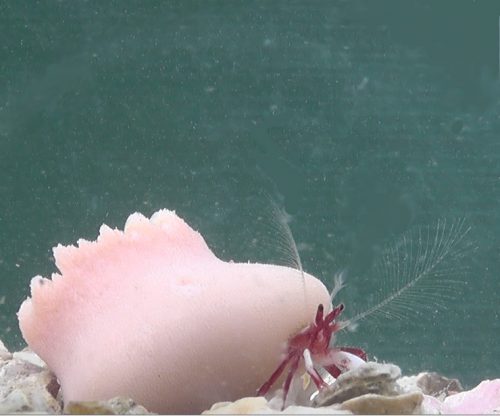A new species of hermit crab, Diogenes heteropsammicola, has been discovered by researchers Momoko Igawa and Makoto Kato in the Oshima Strait of Southern Japan. Instead of inhabiting empty mollusk shells for protection like most species of hermit crab, D. heteropsammicola only delve in walking corals. Walking corals were thought to house only sipunculan worms before this discovery.
Larval walking corals grow on small gastropod shells that are already inhabited by sipunculans. As a walking coral matures, it gradually covers the shell and forms a coiled cavity for a sipunculan. The two organisms then grow together. The worm transports the coral from place to place along the seafloor. This movement is crucial for the coral since it prevents the organism from being buried under sediment or overturned by currents. In return, the walking coral protects the worm from predators with its sturdy shell. The mutually beneficial relationship between the two is called a walking coral symbiosis.
Hermit crabs found in the Oshima Strait offer the same transportation benefit as sipunculans to two species of walking coral: Heterocyathus aequicostatus and Heteropsammia cochlea. Empty molluscan shells are plentiful in the strait, yet the hermit crabs are only found inside walking corals. This suggests that hermit crabs in the area rely solely on walking corals. Such a relationship is termed obligate mutualism. Sipunculans are also entirely dependent on walking corals. The same cannot be said for walking corals since they are able to rely on both hermit crabs and sipunculans for transportation.
Although both symbionts (sipunculans and hermit crabs) inhabit the inside cavity of walking corals, they differ in their feeding habits. Sipunculans are detritus feeders found in more muddier areas, feeding on decomposing fauna and flora in the strait. In contrast, hermit crabs are filter feeders. To obtain food, they pass seawater through special filtering. This difference in feeding pattern between hermit crabs and sipunculans suggests that the location of the two symbioses is different.
From research conducted in the Oshima Strait, Igawa hypothesizes the preferred symbiont of walking corals in the area. “The complete fit of the sipunculan’s body within the corallum cavity and the dominance of sipunculans over the entire distributional range of the corals suggest that the sipunculan is the original symbiont and that the hermit crab is a secondary alternative symbiont. Little is currently known about the evolutionally history of these symbioses,” Igawa says.
Igawa and Kato’s research is interesting because such a “symbiont shift” in an obligate mutualism does not normally occur in nature. In obligate mutualism, species evolve together to become highly specialized in order to maximize the benefit that they receive from one another. When a symbiont shift does happen, the shift usually involves an organism that is phylogenetically close to one of the symbionts. However, in the Oshima strait case, the hermit crabs are phylogenetically distinct from sipunculans.
Fortunately for sipunculan worms, the symbiont shift is not harmful. “When I reared the sipunculans and hermit crabs in the same aquaria, they didn’t fight. In addition, the microhabitat of each symbiosis may be different because their feeding habits differ,” Igawa says. “Thus, I think that they can live together peacefully.”

